CHEVROLET EXPRESS PASSANGER 2006 1.G Owners Manual
Manufacturer: CHEVROLET, Model Year: 2006, Model line: EXPRESS PASSANGER, Model: CHEVROLET EXPRESS PASSANGER 2006 1.GPages: 406, PDF Size: 2.51 MB
Page 241 of 406
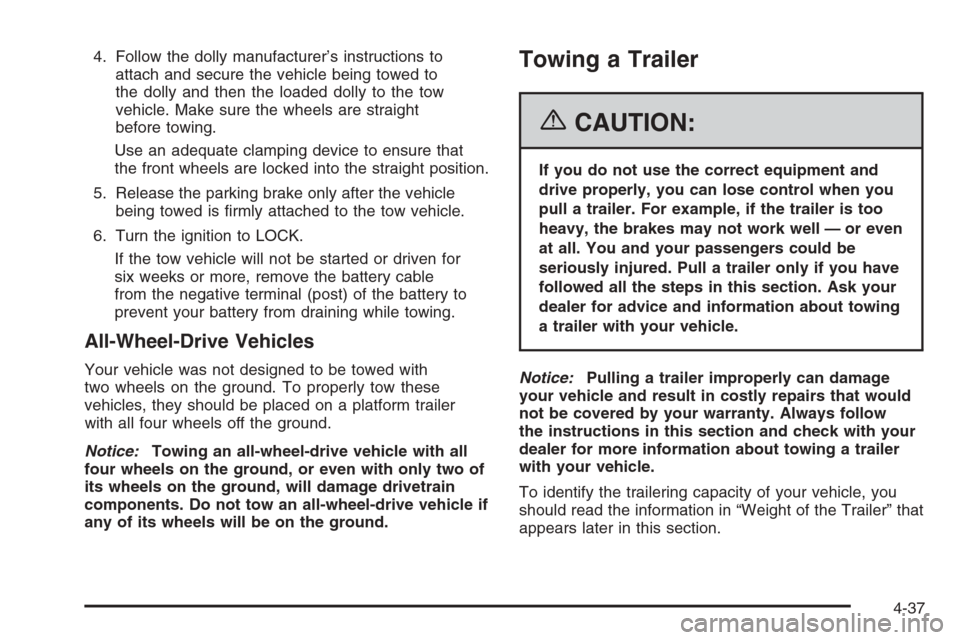
4. Follow the dolly manufacturer’s instructions to
attach and secure the vehicle being towed to
the dolly and then the loaded dolly to the tow
vehicle. Make sure the wheels are straight
before towing.
Use an adequate clamping device to ensure that
the front wheels are locked into the straight position.
5. Release the parking brake only after the vehicle
being towed is firmly attached to the tow vehicle.
6. Turn the ignition to LOCK.
If the tow vehicle will not be started or driven for
six weeks or more, remove the battery cable
from the negative terminal (post) of the battery to
prevent your battery from draining while towing.
All-Wheel-Drive Vehicles
Your vehicle was not designed to be towed with
two wheels on the ground. To properly tow these
vehicles, they should be placed on a platform trailer
with all four wheels off the ground.
Notice:Towing an all-wheel-drive vehicle with all
four wheels on the ground, or even with only two of
its wheels on the ground, will damage drivetrain
components. Do not tow an all-wheel-drive vehicle if
any of its wheels will be on the ground.
Towing a Trailer
{CAUTION:
If you do not use the correct equipment and
drive properly, you can lose control when you
pull a trailer. For example, if the trailer is too
heavy, the brakes may not work well — or even
at all. You and your passengers could be
seriously injured. Pull a trailer only if you have
followed all the steps in this section. Ask your
dealer for advice and information about towing
a trailer with your vehicle.
Notice:Pulling a trailer improperly can damage
your vehicle and result in costly repairs that would
not be covered by your warranty. Always follow
the instructions in this section and check with your
dealer for more information about towing a trailer
with your vehicle.
To identify the trailering capacity of your vehicle, you
should read the information in “Weight of the Trailer” that
appears later in this section.
4-37
Page 242 of 406
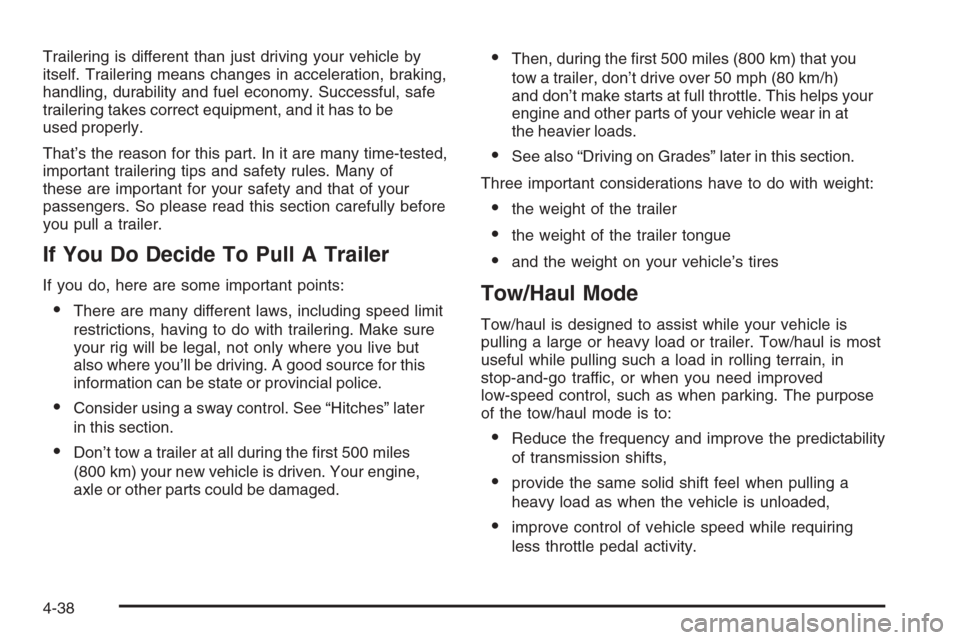
Trailering is different than just driving your vehicle by
itself. Trailering means changes in acceleration, braking,
handling, durability and fuel economy. Successful, safe
trailering takes correct equipment, and it has to be
used properly.
That’s the reason for this part. In it are many time-tested,
important trailering tips and safety rules. Many of
these are important for your safety and that of your
passengers. So please read this section carefully before
you pull a trailer.
If You Do Decide To Pull A Trailer
If you do, here are some important points:
•There are many different laws, including speed limit
restrictions, having to do with trailering. Make sure
your rig will be legal, not only where you live but
also where you’ll be driving. A good source for this
information can be state or provincial police.
•Consider using a sway control. See “Hitches” later
in this section.
•Don’t tow a trailer at all during the first 500 miles
(800 km) your new vehicle is driven. Your engine,
axle or other parts could be damaged.
•Then, during the first 500 miles (800 km) that you
tow a trailer, don’t drive over 50 mph (80 km/h)
and don’t make starts at full throttle. This helps your
engine and other parts of your vehicle wear in at
the heavier loads.
•See also “Driving on Grades” later in this section.
Three important considerations have to do with weight:
•the weight of the trailer
•the weight of the trailer tongue
•and the weight on your vehicle’s tires
Tow/Haul Mode
Tow/haul is designed to assist while your vehicle is
pulling a large or heavy load or trailer. Tow/haul is most
useful while pulling such a load in rolling terrain, in
stop-and-go traffic, or when you need improved
low-speed control, such as when parking. The purpose
of the tow/haul mode is to:
•Reduce the frequency and improve the predictability
of transmission shifts,
•provide the same solid shift feel when pulling a
heavy load as when the vehicle is unloaded,
•improve control of vehicle speed while requiring
less throttle pedal activity.
4-38
Page 243 of 406
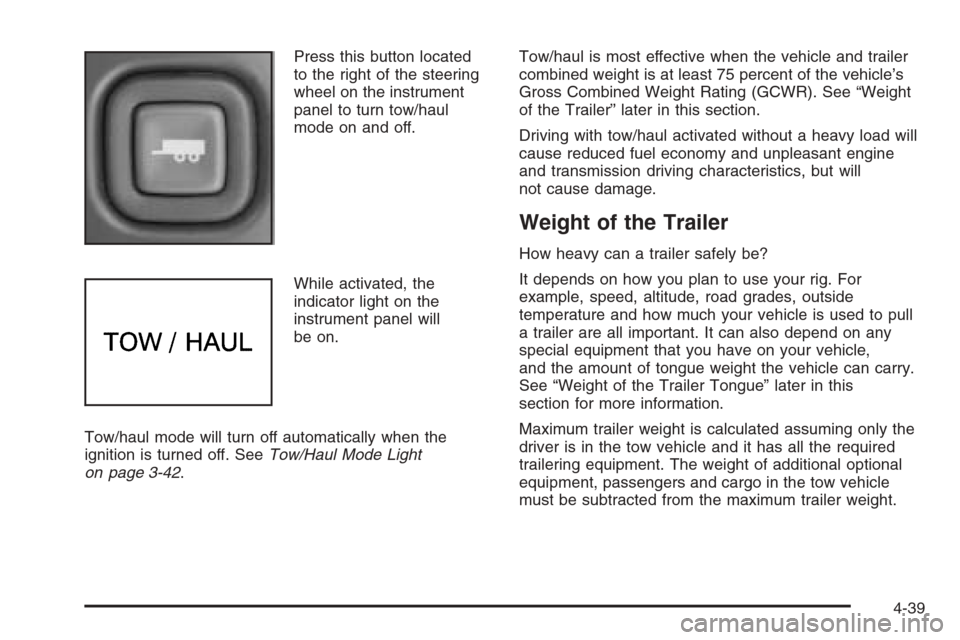
Press this button located
to the right of the steering
wheel on the instrument
panel to turn tow/haul
mode on and off.
While activated, the
indicator light on the
instrument panel will
be on.
Tow/haul mode will turn off automatically when the
ignition is turned off. SeeTow/Haul Mode Light
on page 3-42.Tow/haul is most effective when the vehicle and trailer
combined weight is at least 75 percent of the vehicle’s
Gross Combined Weight Rating (GCWR). See “Weight
of the Trailer” later in this section.
Driving with tow/haul activated without a heavy load will
cause reduced fuel economy and unpleasant engine
and transmission driving characteristics, but will
not cause damage.
Weight of the Trailer
How heavy can a trailer safely be?
It depends on how you plan to use your rig. For
example, speed, altitude, road grades, outside
temperature and how much your vehicle is used to pull
a trailer are all important. It can also depend on any
special equipment that you have on your vehicle,
and the amount of tongue weight the vehicle can carry.
See “Weight of the Trailer Tongue” later in this
section for more information.
Maximum trailer weight is calculated assuming only the
driver is in the tow vehicle and it has all the required
trailering equipment. The weight of additional optional
equipment, passengers and cargo in the tow vehicle
must be subtracted from the maximum trailer weight.
4-39
Page 244 of 406
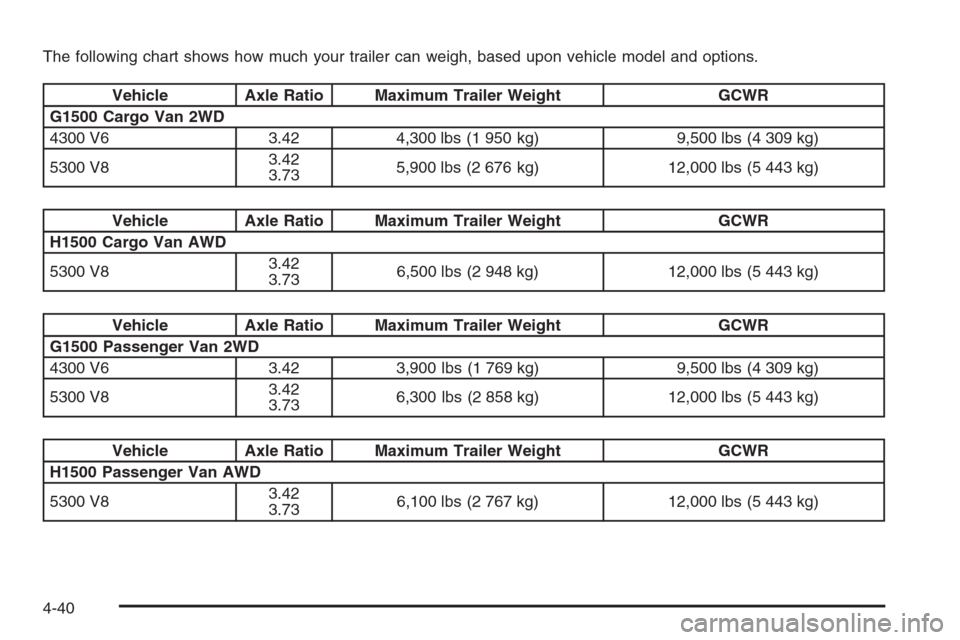
The following chart shows how much your trailer can weigh, based upon vehicle model and options.
Vehicle Axle Ratio Maximum Trailer Weight GCWR
G1500 Cargo Van 2WD
4300 V6 3.42 4,300 lbs (1 950 kg) 9,500 lbs (4 309 kg)
5300 V83.42
3.735,900 lbs (2 676 kg) 12,000 lbs (5 443 kg)
Vehicle Axle Ratio Maximum Trailer Weight GCWR
H1500 Cargo Van AWD
5300 V83.42
3.736,500 lbs (2 948 kg) 12,000 lbs (5 443 kg)
Vehicle Axle Ratio Maximum Trailer Weight GCWR
G1500 Passenger Van 2WD
4300 V6 3.42 3,900 lbs (1 769 kg) 9,500 lbs (4 309 kg)
5300 V83.42
3.736,300 lbs (2 858 kg) 12,000 lbs (5 443 kg)
Vehicle Axle Ratio Maximum Trailer Weight GCWR
H1500 Passenger Van AWD
5300 V83.42
3.736,100 lbs (2 767 kg) 12,000 lbs (5 443 kg)
4-40
Page 245 of 406
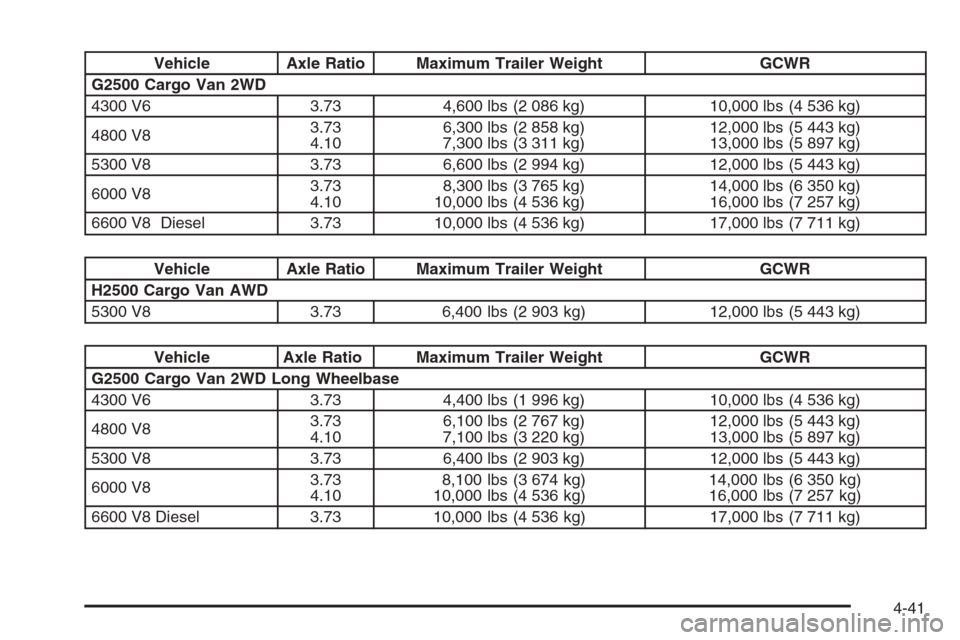
Vehicle Axle Ratio Maximum Trailer Weight GCWR
G2500 Cargo Van 2WD
4300 V6 3.73 4,600 lbs (2 086 kg) 10,000 lbs (4 536 kg)
4800 V83.73
4.106,300 lbs (2 858 kg)
7,300 lbs (3 311 kg)12,000 lbs (5 443 kg)
13,000 lbs (5 897 kg)
5300 V8 3.73 6,600 lbs (2 994 kg) 12,000 lbs (5 443 kg)
6000 V83.73
4.108,300 lbs (3 765 kg)
10,000 lbs (4 536 kg)14,000 lbs (6 350 kg)
16,000 lbs (7 257 kg)
6600 V8 Diesel 3.73 10,000 lbs (4 536 kg) 17,000 lbs (7 711 kg)
Vehicle Axle Ratio Maximum Trailer Weight GCWR
H2500 Cargo Van AWD
5300 V8 3.73 6,400 lbs (2 903 kg) 12,000 lbs (5 443 kg)
Vehicle Axle Ratio Maximum Trailer Weight GCWR
G2500 Cargo Van 2WD Long Wheelbase
4300 V6 3.73 4,400 lbs (1 996 kg) 10,000 lbs (4 536 kg)
4800 V83.73
4.106,100 lbs (2 767 kg)
7,100 lbs (3 220 kg)12,000 lbs (5 443 kg)
13,000 lbs (5 897 kg)
5300 V8 3.73 6,400 lbs (2 903 kg) 12,000 lbs (5 443 kg)
6000 V83.73
4.108,100 lbs (3 674 kg)
10,000 lbs (4 536 kg)14,000 lbs (6 350 kg)
16,000 lbs (7 257 kg)
6600 V8 Diesel 3.73 10,000 lbs (4 536 kg) 17,000 lbs (7 711 kg)
4-41
Page 246 of 406
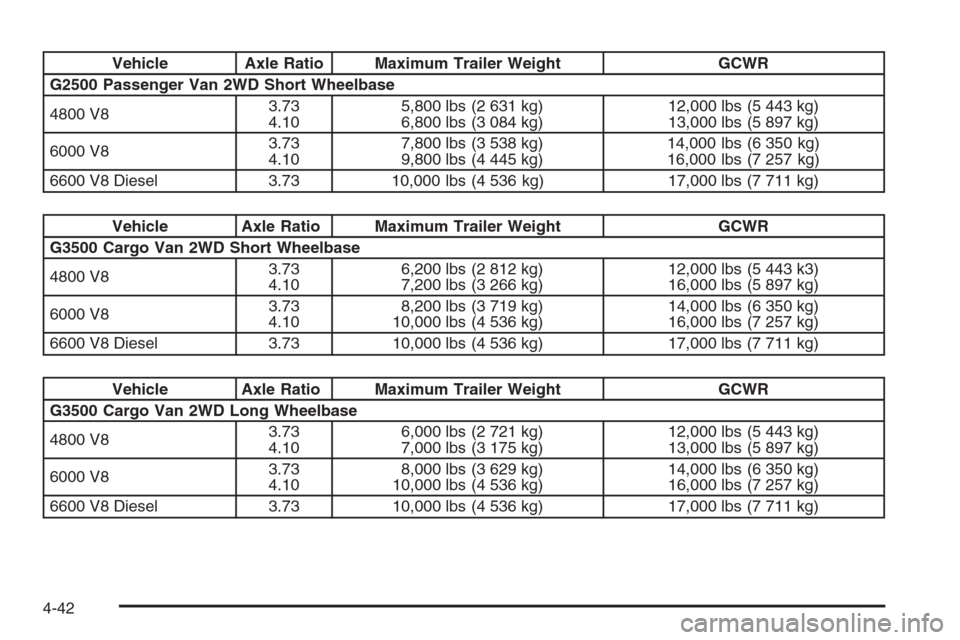
Vehicle Axle Ratio Maximum Trailer Weight GCWR
G2500 Passenger Van 2WD Short Wheelbase
4800 V83.73
4.105,800 lbs (2 631 kg)
6,800 lbs (3 084 kg)12,000 lbs (5 443 kg)
13,000 lbs (5 897 kg)
6000 V83.73
4.107,800 lbs (3 538 kg)
9,800 lbs (4 445 kg)14,000 lbs (6 350 kg)
16,000 lbs (7 257 kg)
6600 V8 Diesel 3.73 10,000 lbs (4 536 kg) 17,000 lbs (7 711 kg)
Vehicle Axle Ratio Maximum Trailer Weight GCWR
G3500 Cargo Van 2WD Short Wheelbase
4800 V83.73
4.106,200 lbs (2 812 kg)
7,200 lbs (3 266 kg)12,000 lbs (5 443 k3)
16,000 lbs (5 897 kg)
6000 V83.73
4.108,200 lbs (3 719 kg)
10,000 lbs (4 536 kg)14,000 lbs (6 350 kg)
16,000 lbs (7 257 kg)
6600 V8 Diesel 3.73 10,000 lbs (4 536 kg) 17,000 lbs (7 711 kg)
Vehicle Axle Ratio Maximum Trailer Weight GCWR
G3500 Cargo Van 2WD Long Wheelbase
4800 V83.73
4.106,000 lbs (2 721 kg)
7,000 lbs (3 175 kg)12,000 lbs (5 443 kg)
13,000 lbs (5 897 kg)
6000 V83.73
4.108,000 lbs (3 629 kg)
10,000 lbs (4 536 kg)14,000 lbs (6 350 kg)
16,000 lbs (7 257 kg)
6600 V8 Diesel 3.73 10,000 lbs (4 536 kg) 17,000 lbs (7 711 kg)
4-42
Page 247 of 406
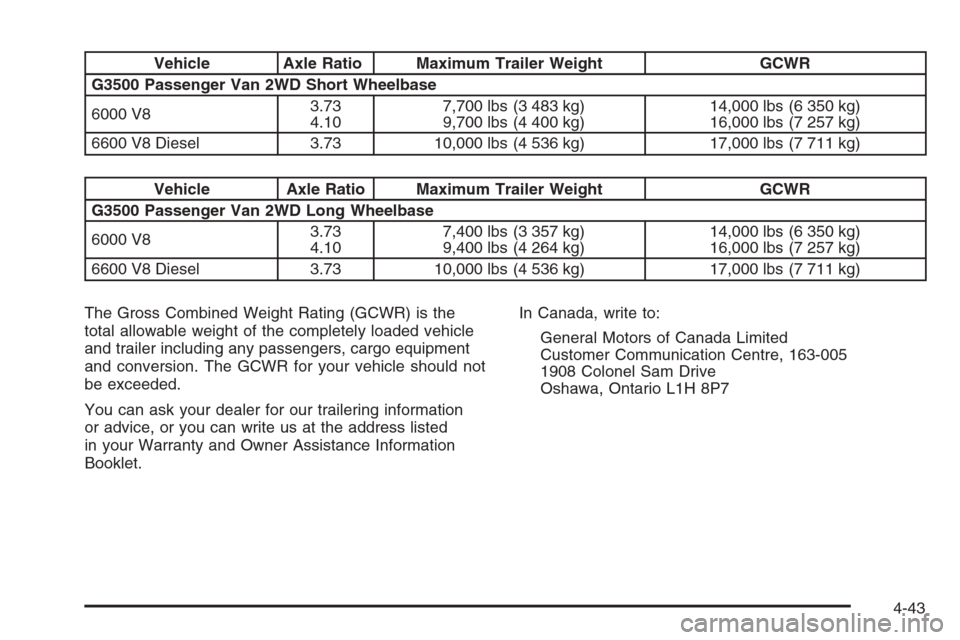
Vehicle Axle Ratio Maximum Trailer Weight GCWR
G3500 Passenger Van 2WD Short Wheelbase
6000 V83.73
4.107,700 lbs (3 483 kg)
9,700 lbs (4 400 kg)14,000 lbs (6 350 kg)
16,000 lbs (7 257 kg)
6600 V8 Diesel 3.73 10,000 lbs (4 536 kg) 17,000 lbs (7 711 kg)
Vehicle Axle Ratio Maximum Trailer Weight GCWR
G3500 Passenger Van 2WD Long Wheelbase
6000 V83.73
4.107,400 lbs (3 357 kg)
9,400 lbs (4 264 kg)14,000 lbs (6 350 kg)
16,000 lbs (7 257 kg)
6600 V8 Diesel 3.73 10,000 lbs (4 536 kg) 17,000 lbs (7 711 kg)
The Gross Combined Weight Rating (GCWR) is the
total allowable weight of the completely loaded vehicle
and trailer including any passengers, cargo equipment
and conversion. The GCWR for your vehicle should not
be exceeded.
You can ask your dealer for our trailering information
or advice, or you can write us at the address listed
in your Warranty and Owner Assistance Information
Booklet.In Canada, write to:
General Motors of Canada Limited
Customer Communication Centre, 163-005
1908 Colonel Sam Drive
Oshawa, Ontario L1H 8P7
4-43
Page 248 of 406
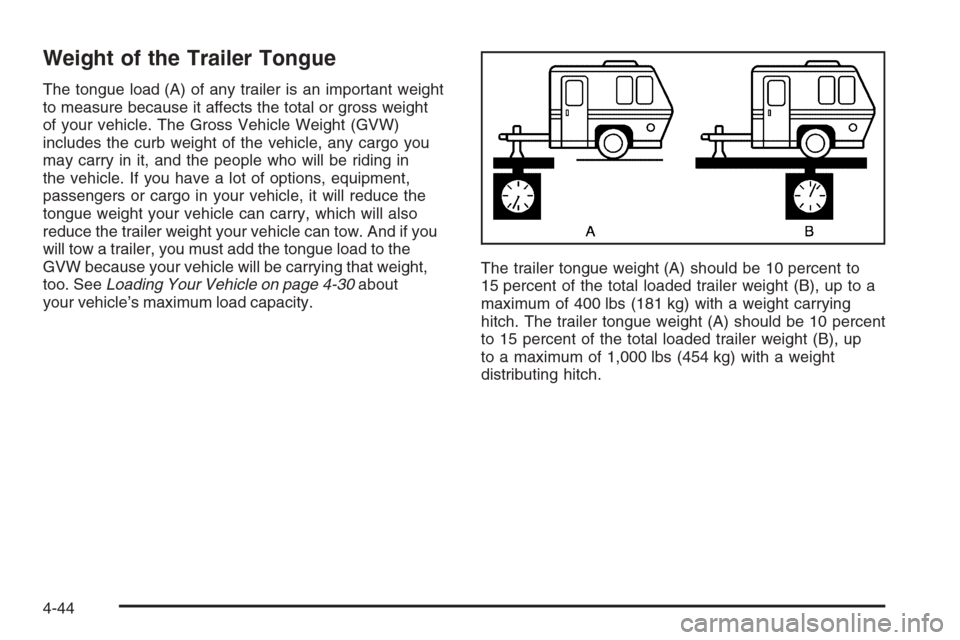
Weight of the Trailer Tongue
The tongue load (A) of any trailer is an important weight
to measure because it affects the total or gross weight
of your vehicle. The Gross Vehicle Weight (GVW)
includes the curb weight of the vehicle, any cargo you
may carry in it, and the people who will be riding in
the vehicle. If you have a lot of options, equipment,
passengers or cargo in your vehicle, it will reduce the
tongue weight your vehicle can carry, which will also
reduce the trailer weight your vehicle can tow. And if you
will tow a trailer, you must add the tongue load to the
GVW because your vehicle will be carrying that weight,
too. SeeLoading Your Vehicle on page 4-30about
your vehicle’s maximum load capacity.The trailer tongue weight (A) should be 10 percent to
15 percent of the total loaded trailer weight (B), up to a
maximum of 400 lbs (181 kg) with a weight carrying
hitch. The trailer tongue weight (A) should be 10 percent
to 15 percent of the total loaded trailer weight (B), up
to a maximum of 1,000 lbs (454 kg) with a weight
distributing hitch.
4-44
Page 249 of 406
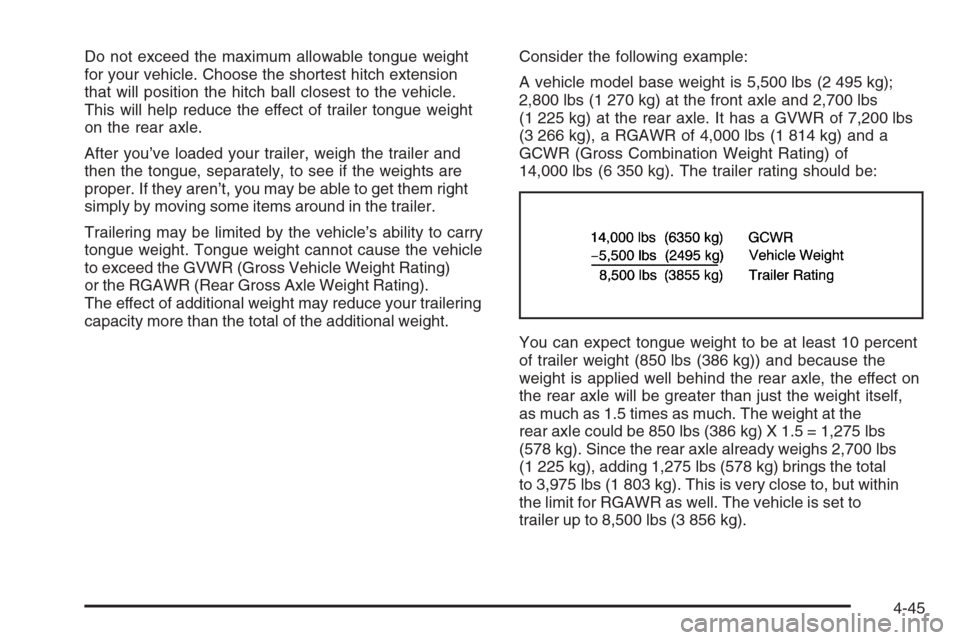
Do not exceed the maximum allowable tongue weight
for your vehicle. Choose the shortest hitch extension
that will position the hitch ball closest to the vehicle.
This will help reduce the effect of trailer tongue weight
on the rear axle.
After you’ve loaded your trailer, weigh the trailer and
then the tongue, separately, to see if the weights are
proper. If they aren’t, you may be able to get them right
simply by moving some items around in the trailer.
Trailering may be limited by the vehicle’s ability to carry
tongue weight. Tongue weight cannot cause the vehicle
to exceed the GVWR (Gross Vehicle Weight Rating)
or the RGAWR (Rear Gross Axle Weight Rating).
The effect of additional weight may reduce your trailering
capacity more than the total of the additional weight.Consider the following example:
A vehicle model base weight is 5,500 lbs (2 495 kg);
2,800 lbs (1 270 kg) at the front axle and 2,700 lbs
(1 225 kg) at the rear axle. It has a GVWR of 7,200 lbs
(3 266 kg), a RGAWR of 4,000 lbs (1 814 kg) and a
GCWR (Gross Combination Weight Rating) of
14,000 lbs (6 350 kg). The trailer rating should be:
You can expect tongue weight to be at least 10 percent
of trailer weight (850 lbs (386 kg)) and because the
weight is applied well behind the rear axle, the effect on
the rear axle will be greater than just the weight itself,
as much as 1.5 times as much. The weight at the
rear axle could be 850 lbs (386 kg) X 1.5 = 1,275 lbs
(578 kg). Since the rear axle already weighs 2,700 lbs
(1 225 kg), adding 1,275 lbs (578 kg) brings the total
to 3,975 lbs (1 803 kg). This is very close to, but within
the limit for RGAWR as well. The vehicle is set to
trailer up to 8,500 lbs (3 856 kg).
4-45
Page 250 of 406
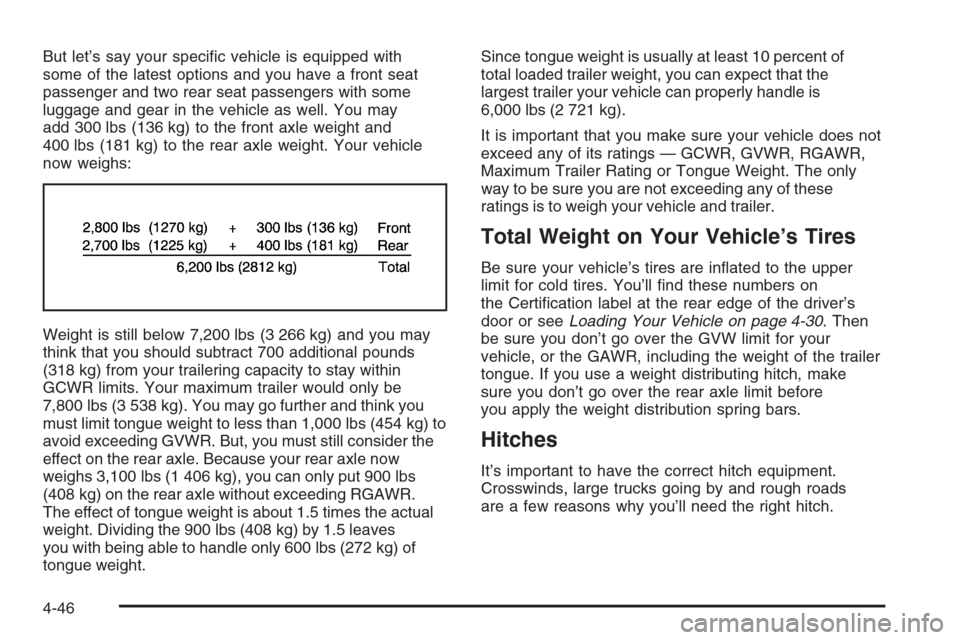
But let’s say your specific vehicle is equipped with
some of the latest options and you have a front seat
passenger and two rear seat passengers with some
luggage and gear in the vehicle as well. You may
add 300 lbs (136 kg) to the front axle weight and
400 lbs (181 kg) to the rear axle weight. Your vehicle
now weighs:
Weight is still below 7,200 lbs (3 266 kg) and you may
think that you should subtract 700 additional pounds
(318 kg) from your trailering capacity to stay within
GCWR limits. Your maximum trailer would only be
7,800 lbs (3 538 kg). You may go further and think you
must limit tongue weight to less than 1,000 lbs (454 kg) to
avoid exceeding GVWR. But, you must still consider the
effect on the rear axle. Because your rear axle now
weighs 3,100 lbs (1 406 kg), you can only put 900 lbs
(408 kg) on the rear axle without exceeding RGAWR.
The effect of tongue weight is about 1.5 times the actual
weight. Dividing the 900 lbs (408 kg) by 1.5 leaves
you with being able to handle only 600 lbs (272 kg) of
tongue weight.Since tongue weight is usually at least 10 percent of
total loaded trailer weight, you can expect that the
largest trailer your vehicle can properly handle is
6,000 lbs (2 721 kg).
It is important that you make sure your vehicle does not
exceed any of its ratings — GCWR, GVWR, RGAWR,
Maximum Trailer Rating or Tongue Weight. The only
way to be sure you are not exceeding any of these
ratings is to weigh your vehicle and trailer.
Total Weight on Your Vehicle’s Tires
Be sure your vehicle’s tires are inflated to the upper
limit for cold tires. You’ll find these numbers on
the Certification label at the rear edge of the driver’s
door or seeLoading Your Vehicle on page 4-30. Then
be sure you don’t go over the GVW limit for your
vehicle, or the GAWR, including the weight of the trailer
tongue. If you use a weight distributing hitch, make
sure you don’t go over the rear axle limit before
you apply the weight distribution spring bars.
Hitches
It’s important to have the correct hitch equipment.
Crosswinds, large trucks going by and rough roads
are a few reasons why you’ll need the right hitch.
4-46